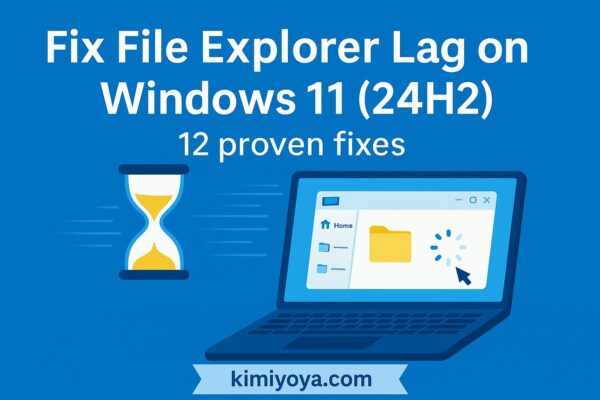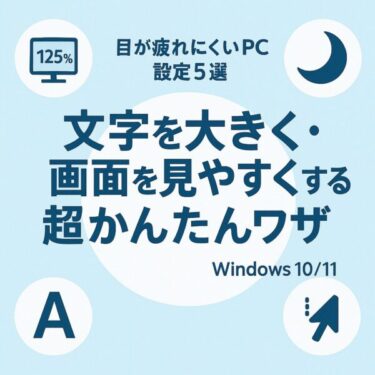
“Folders take forever to open.”
“Right-click lags, tabs feel sticky, and sometimes Explorer turns white and says Not Responding.”
If that sounds familiar after a recent Windows 11 update, you’re not alone. Major feature updates (like 24H2) often kick off background tasks—index rebuilding, thumbnail/cache resets, and cloud re-syncs—that can temporarily bog down File Explorer. In other cases, outdated shell extensions or aggressive startup apps are the true culprits.
This guide explains why File Explorer slows down and gives you safe, practical fixes to try in order. Most machines recover with a handful of tweaks—no reset required.
- 1 Fixes (start at the top and go in order)
- 1.1 1) Quick reset: restart Explorer
- 1.2 2) Update Windows and drivers
- 1.3 3) Lighten the Home view
- 1.4 4) Pause OneDrive temporarily (for diagnosis)
- 1.5 5) Clear Explorer history & thumbnail cache
- 1.6 6) Trim startup apps (reduces background contention)
- 1.7 7) Tame tab bloat or reset the Explorer process
- 1.8 8) Hunt down bad shell extensions (top cause of right-click lag)
- 1.9 9) Repair system files (safe, built-in)
- 1.10 10) Optional: Temporarily reduce Search indexing load
- 1.11 11) If problems persist: clean boot / Safe Mode
- 1.12 12) When to consider a reset
- 2 Pro tips for long-term smoothness
Who this guide is for
- Everyday users whose File Explorer became sluggish after a Windows update
- Power users noticing tabbed Explorer getting heavy with multiple tabs
- Anyone seeing right-click lag, white window / Not Responding, or slow Home view
Common symptoms
- Opening any folder or drive takes several seconds (or longer)
- Explorer window flashes white and shows Not Responding, then recovers or crashes
- Context menu (right-click) appears with a long delay
- Taskbar/Start also feel laggy (they’re tied to
explorer.exe) - Tabs in Explorer feel progressively slower as you open more
Why it happens (in plain English)
- Background rebuilding after updates. Search index, thumbnail cache, and other optimizations run in the background; your PC may feel busy for a while.
- Cloud sync overhead. OneDrive/other cloud providers refresh status icons, thumbnails, and metadata.
- Third-party shell extensions. Old or buggy extensions (preview handlers, custom context menus) can hang Explorer.
- Home view overhead. The Home page aggregates “recent” and “frequent” content; on some PCs it adds noticeable delay.
- Too many Explorer tabs. Tabbed Explorer is convenient, but heavy multitasking can spike
explorer.exe.
Fixes (start at the top and go in order)
Tip: After a big update, giving your PC a few idle hours (screen off is fine, but don’t sleep/hibernate) can let indexing and optimization finish. Try the quick fixes first; if you still feel lag, leave the machine plugged in and idle for a while.
1) Quick reset: restart Explorer
- Press Ctrl + Shift + Esc to open Task Manager.
- Select Windows Explorer → click Restart (bottom right).
Small hiccups often clear immediately.
2) Update Windows and drivers
Before deep dives, make sure you’re on the latest cumulative update for Windows 11 and your GPU/storage drivers are current. Stability and performance fixes roll out continuously and can directly affect Explorer responsiveness.
3) Lighten the Home view
The Home page can be noisy on some PCs.
- Open File Explorer → … (top-right) → Options.
- General tab:
- Set “Open File Explorer to:” This PC (instead of Home).
- Uncheck Show recently used files and Show frequently used folders if you don’t need them.
- At Privacy → click Clear to wipe Explorer history (you won’t lose files; just the shortcuts).
4) Pause OneDrive temporarily (for diagnosis)
If Explorer feels faster while cloud sync is paused, you’ve found a factor.
- Click the OneDrive cloud icon in the taskbar.
- Settings (gear) → Pause syncing (choose 2 hours).
- Test folder navigation. If it’s clearly better, consider:
- Excluding large, seldom-used folders from real-time sync
- Keeping “Files On-Demand” enabled so only needed files hydrate
- Ensuring the OneDrive folder isn’t on a slow/near-full drive
(When done testing, resume sync from the same menu.)
5) Clear Explorer history & thumbnail cache
A) Clear history (again, just shortcuts):
- File Explorer → … → Options → Clear.
B) Clear temporary files and thumbnails:
- Press Win + R, type
cleanmgr, press Enter. - Select your system drive (C:).
- Check Temporary files and Thumbnails → OK → Delete files.
6) Trim startup apps (reduces background contention)
- Ctrl + Shift + Esc → Startup apps tab.
- Disable non-essential items (you can re-enable later).
- Reboot and test Explorer.
7) Tame tab bloat or reset the Explorer process
Tabbed Explorer can get heavy with lots of open tabs.
- Keep it to 3–4 tabs when possible.
- If it bogs down mid-session, do a “hard reset” of the Explorer process:
taskkill /f /im explorer.exe start explorer.exe
(Run from Terminal/Command Prompt as a normal user.)
8) Hunt down bad shell extensions (top cause of right-click lag)
Third-party shell extensions are a classic source of Explorer delays. Use ShellExView to pinpoint offenders:
- Download ShellExView (search for “NirSoft ShellExView”).
- Run as administrator.
- Sort by Company and temporarily disable non-Microsoft entries (one group at a time).
- Test Explorer after each change. If latency disappears, update or remove the guilty app/extension.
Notes:
- Be systematic—disable a batch, test, then narrow down.
- Preview handlers and context-menu extensions are frequent suspects.
9) Repair system files (safe, built-in)
Corrupted system components can slow or crash Explorer.
- Right-click Start → Terminal (Admin).
- Run, in order:
sfc /scannow DISM /Online /Cleanup-Image /RestoreHealth - Reboot when finished.
10) Optional: Temporarily reduce Search indexing load
Useful only for diagnosis if indexing churns your disk/CPU right after an update.
- Press Win + R, type
services.msc, press Enter. - Double-click Windows Search → set Startup type: Manual and click Stop.
- Test Explorer for a while. If it’s clearly better, leave it off for a day, then set it back to Automatic so Windows Search works normally again.
11) If problems persist: clean boot / Safe Mode
- Clean boot: Start Windows with only Microsoft services to rule out app conflicts.
- Safe Mode: If Explorer is snappy here, third-party drivers/services are very likely at fault.
- Gradually re-enable items to find the conflict.
12) When to consider a reset
You typically do not need to reset or reinstall Windows for Explorer lag. Consider reset only if:
- SFC/DISM find issues that return repeatedly
- Clean boot/Safe Mode clearly solve it, but the culprit app/driver is unavoidable
- You’ve updated Windows/drivers and tried all steps with no improvement
Back up first, and try “Reset this PC” (Keep my files) before a clean install.
Pro tips for long-term smoothness
- Keep Windows and GPU/storage drivers current.
- Avoid opening 10+ Explorer tabs for long sessions.
- Give the PC overnight idle time after major updates (plugged in, screen off, no sleep).
- Watch disk space. NVMe SSDs slow down when nearly full; keep 15–20% free.
- Mind your extensions. If you install context-menu/preview utilities, update them regularly.
Troubleshooting checklist (print-friendly)
- Restarted
explorer.exe - Updated Windows + GPU/storage drivers
- Set Open File Explorer to: This PC
- Cleared Explorer history & thumbnails
- Paused OneDrive briefly (and adjusted sync scope)
- Trimmed startup apps
- Limited tabs or reset Explorer process
- Disabled non-Microsoft shell extensions (tested in batches)
- Ran SFC and DISM
- Tried clean boot / Safe Mode
- Left PC idle overnight post-update
Recommended tools & gear (optional, but helpful)
Lightweight, genuinely helpful suggestions—add only what fits your audience.
1) Microsoft 365 for seamless OneDrive + Office
Keep your documents synced and your Office apps current—helpful when you rely on OneDrive file status and quick previews.
[Sponsored]
Microsoft 365 Personal
- Always-up-to-date Word/Excel/PowerPoint
- 1 TB OneDrive for automatic backup
- Use across PC, phone, and tablet
2) USB flash drive (quick backups / offloading large folders)
[Sponsored]
USB 3.x Flash Drives
- Move big folders before cleanup
- Handy for quick, offline backups
FAQ
Q. Explorer is slow and my entire desktop feels choppy. Is this still an Explorer problem?
A. Not necessarily. Check Task Manager → Performance for disk/CPU spikes, and verify you have sufficient free SSD space. Also test with OneDrive paused and a clean boot.
Q. Is it safe to disable Windows Search permanently?
A. It’s fine to pause/disable temporarily for diagnosis. Long-term, keep it enabled—it powers Start/Explorer search.
Q. My right-click is instant in Safe Mode. What now?
A. That’s a classic sign of a third-party shell extension. Use ShellExView to disable non-Microsoft items in normal mode, test, then narrow down and update/remove the culprit.
Q. Should I roll back the update?
A. Use rollback only if the issue is severe and recent. Try the fixes above first; if you choose to roll back, do it soon after an update (the option is time-limited) and back up your files.
Conclusion
After big Windows releases, temporary slowdowns in File Explorer are common and usually solvable. Start with quick resets, keep Windows/drivers updated, trim the Home view and startup apps, and test with cloud sync paused. If right-click is the bottleneck, go straight to shell extensions. With a bit of patience (and sometimes an overnight idle), most PCs return to normal without drastic measures.
Related Articles
・How to Fix Windows Update Error 0x80070003


